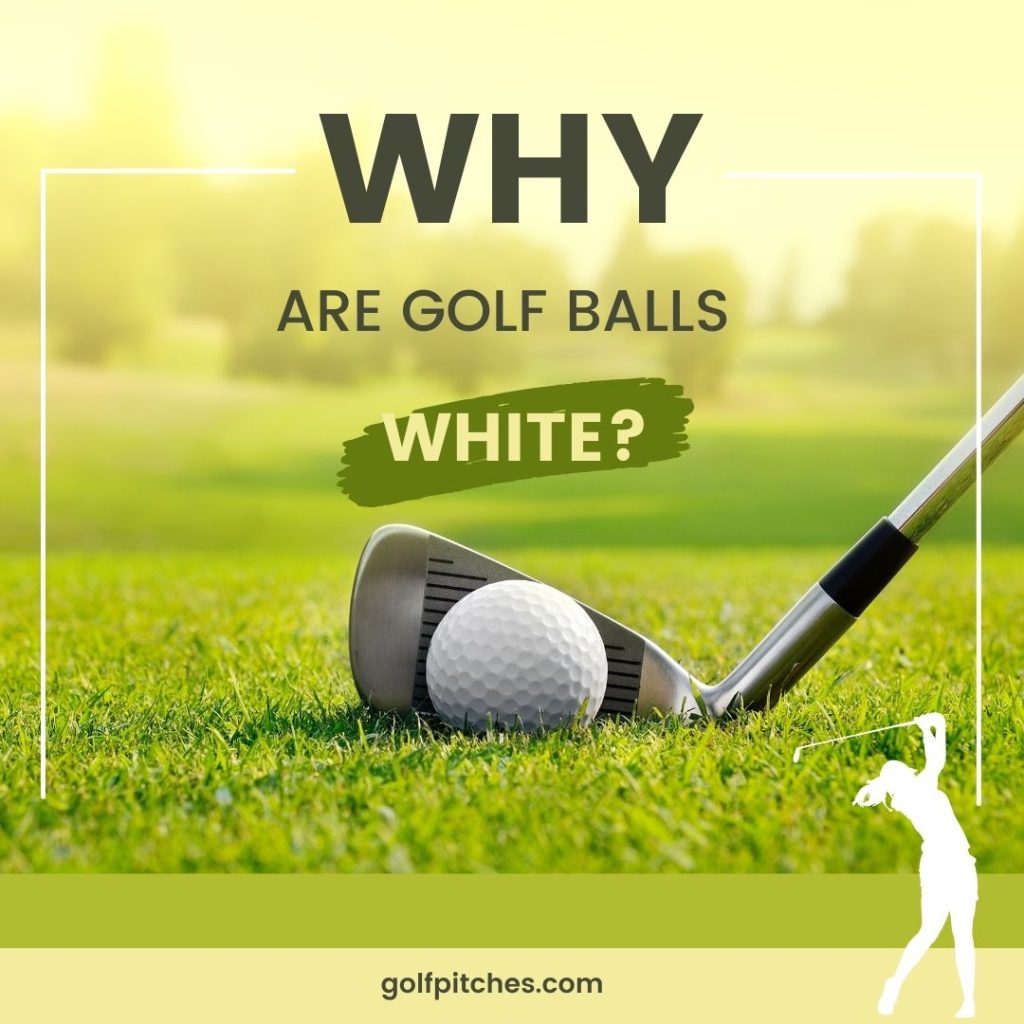If you’ve ever found yourself on the green, meticulously selecting your club, calculating wind speed, and pondering your swing mechanics, you’ve likely also glanced down at that small, dimpled, white sphere and wondered, “Why are golf balls white?”
Today, we’re going to explore a seemingly simple yet profoundly impactful aspect of the game: the traditional white color of golf balls.

The color of a golf ball may seem inconsequential at first glance, but as we’ll uncover, it’s a subject steeped in history, science, and even psychology.
Whether you’re a weekend warrior looking to shave a few strokes off your game, or a seasoned pro curious about the finer details, understanding the rationale behind the white golf balls can offer intriguing insights into this beloved sport.
In this article, we’ll journey through the annals of golf history, delve into visibility studies conducted under various lighting conditions, explore the psychological effects of color, and even touch on the technological advancements that are challenging the status quo.
So, grab your favorite putter, and let’s dive into the fascinating world of golf ball coloration.
One of the most compelling reasons for golf balls being white is their visibility against green fairways and blue skies. White offers a high contrast, making it easier for players to spot the ball from a distance.
Related: Best Golf Ball Color for Fall
Why Are Golf Balls White
1. Visibility
One of the most practical reasons for golf balls being white is visibility. The white color contrasts sharply against the green fairways, making it easier for players to spot the ball from a distance. This is particularly important in professional tournaments where precise shots are crucial.
Similarly, a white golf ball is easier to track against a blue sky during flight. This is not just anecdotal; studies in sports optics have shown that white objects are generally easier to spot against varying backgrounds, enhancing the player’s ability to predict the ball’s landing spot.
2. Tradition and Regulation
The tradition of using white golf balls dates back to the early 20th century and has been maintained ever since. Golf is a sport steeped in tradition, and the white color has become an integral part of the game’s identity.
Various golfing bodies and organizations have regulations that include specifications for golf balls, although color is generally not strictly regulated. The USGA and The R&A, for instance, do not specifically mandate the color of the golf ball. However, the tradition of using white balls is so ingrained that it has become a de facto standard.
Major tournaments like The Masters and the U.S. Open predominantly feature white golf balls, reinforcing the tradition.
3. Psychological Factors
The color white is often associated with purity, clarity, and focus—all attributes that can positively influence a player’s mindset. Dr. Sally Linkenauger from Lancaster University has conducted research suggesting that color can indeed affect performance, although the studies are not golf-specific.
Anecdotal evidence suggests that some players find it easier to focus on a white ball, attributing qualities like “cleanliness” and “precision” to the color.
4. Technological Limitations
Earlier materials like gutta-percha and balata were more conducive to being manufactured in white. The color also made it easier to spot imperfections in the ball, ensuring higher quality control.
White paint was easier and more cost-effective to produce and apply, especially when golf balls began to be mass-produced. Companies like Titleist and Callaway have maintained the traditional white color in most of their product lines for these reasons.
Alternative Colors in Golf Balls
While the classic white golf ball remains the most popular choice among golfers, the market has seen a surge in alternative colors in recent years. These colors not only offer a fresh aesthetic but also come with their own set of advantages and considerations.

- Yellow Golf Balls: Yellow is arguably the most popular alternative to white. The Titleist AVX and the Callaway Supersoft both come in yellow variants. Yellow golf balls are especially visible in overcast conditions or on courses with lots of shadows. They can also be easier to spot in the rough or in fall conditions when leaves are on the ground.
- Orange Golf Balls: Orange is another color that’s gained traction, especially among younger players. It’s hard to confuse your ball with someone else’s when it’s a bright orange, and like yellow, orange can be easier to spot in certain conditions. The Srixon Soft Feel and the Wilson Staff Duo Optix are available in orange.
- Pink Golf Balls: Pink golf balls are less common but have a niche market. Some brands release pink balls in support of breast cancer awareness. The Volvik Vivid and the Bridgestone e6 Lady are available in pink.
- Matte Finish: Beyond just color, the finish of the ball can also vary. Matte finishes, often seen in colors like red, blue, and green, are becoming increasingly popular. Matte finishes can reduce sun glare, making the ball easier to spot. And on top of that, The matte look is modern and can be appealing to many golfers. The Volvik Vivid series offers a range of matte-finished balls in various colors.
- Multi-colored Golf Balls: For those looking to add some fun to their game, there are multi-colored and novelty balls. These can be patterned, have emojis, or even glow in the dark. Callaway’s Truvis pattern (often seen on their Chrome Soft balls) is a multi-colored design that aids in visibility and focus.
Why Beginners Stick with White Golf Balls
I’ve had the privilege of playing with a wide range of golf balls—from the Titleist Pro V1s to the Callaway Chrome Softs.
Recently, I’ve been asking beginner golfers about their preferences when it comes to golf ball colors. The overwhelming majority seem to gravitate towards white golf balls. So, I naturally found myself asking myself why is that? And consequently came up with the following probable reasons:
Professional Golfers Mostly Use White Golf Balls
When you’re new to the game, it’s natural to look up to the pros for inspiration. Whether it’s emulating Tiger Woods’ swing or Phil Mickelson’s short game, beginners often follow in the footsteps of the greats.
The same goes for equipment.
Pros predominantly use white golf balls, and brands like Titleist, Callaway, and Bridgestone heavily market their white balls through these players. The Pro V1, Chrome Soft, and Tour B series are all flagship models that are predominantly white. The influence of these professionals and brands cannot be overstated.
White Golf Balls Have Better Visibility and Playability
White balls offer excellent visibility against the green fairways and blue skies, a crucial factor in a sport where tracking the ball is vital. While colored balls like the Volvik Vivid series or the Callaway Supersoft in yellow and orange do offer good visibility, they are generally considered more of a niche market. Beginners often aren’t aware of these options and stick to what they know—white.
White Golf Balls are Readily Available at Pocket-Friendly Budgets
Walk into any pro shop or sporting goods store, and you’ll find that the majority of golf balls for sale are white.
Brands like Wilson and Pinnacle offer budget-friendly white golf balls, such as the Wilson Ultra 500 or the Pinnacle Soft, making them accessible options for beginners who aren’t looking to invest heavily in equipment right off the bat.
The Role of Fitting and Customization
As players advance, they often go through a ball fitting process, much like they would for clubs. This process takes into account swing speed, launch angle, and a host of other factors.
Customization can extend to the color of the ball, but beginners usually haven’t reached this stage. They’re more likely to grab a sleeve of white balls and head to the first tee.
While the world of golf balls is more colorful than ever, with advancements in technology allowing for a variety of hues and finishes, white remains the go-to color for beginners.
Influenced by professional players, tradition, and the sheer availability of white balls, newcomers find themselves sticking to what is familiar and readily available.
As you progress in your golf journey, you may find yourself experimenting with different colors and finishes, but the classic white ball serves as the starting point for most.
The Genesis of the White Golf Ball
The history of golf balls is a fascinating journey that takes us from wooden balls to “featheries”—leather pouches filled with boiled feathers—and eventually to “gutties,” made from the sap of the Gutta-percha tree.
Brands like Spalding were among the pioneers in the mass production of gutties. These early balls came in various colors, but as the 20th century rolled around, white became the standard.
Early materials like gutta-percha and balata lent themselves well to being manufactured in white. Companies like Titleist, which introduced the first commercially successful wound golf ball, the Titleist DT, in 1935, found that white paint was not only easier to produce but also facilitated quality control by making imperfections easier to spot.
By the early 20th century, white became the color of choice, especially with the introduction of the Haskell ball—a rubber-cored ball that revolutionized distance and durability. Brands like Dunlop and Wilson followed suit, solidifying white as the standard hue.
The transition to white golf balls was influenced by several factors, including visibility and the advent of new materials like rubber. As golf courses became more expansive and the game more competitive, the need for a ball that could be easily spotted became paramount.
White was found to offer the best visibility against the green fairways and blue skies, setting the stage for the iconic white golf ball we know today.
In summary, the tradition of white golf balls is a blend of historical legacy, practical benefits, psychological advantages, and even technological limitations. It’s a tradition that has stood the test of time and continues to be prevalent in the game today.
